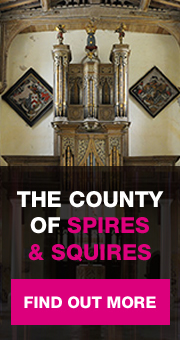St Mary the Virgin is a fine, 13th Century Grade I listed mediaeval Northamptonshire ironstone and limestone church with a spectacular tower and broach spire.
Under the direction of Sir George Gilbert Scott, the Revd Richard Pulteney restored and refurbished the church between 1864 and 1866, to conform with the principles laid down by the Cambridge Camden Society.
The main body of the church was completely restored and refurnished with oak pews decorated with delicate foliate carvings, an impressive oak pulpit and a magnificent oak priest’s desk - all hand-carved.
However, it is the sumptuous chancel decorated with marble, alabaster, semi-precious stones and gold leaf, which makes this church remarkable; it is described by Historic England, “an outstanding example of Victorian Gothic style at its height”. The designs in the chancel are the work of Clayton and Bell, whose theme was the “Te Deum Laudamus”. Groups of figures illustrating verses from the anthem cover the walls, thus: the “Glorious Company of the Apostles” on the north wall; “Goodly Fellowship of the Prophets” on the south wall, and “Noble Army of Martyrs” facing the altar on the west wall. In total, there are some fifty human figures and twenty-two angels! The painted barrel ceiling is reminiscent of the chancel in Peterborough Cathedral. Clayton and Bell were responsible also for the stained-glass windows, and the chandeliers were the work of George Bodley. No expense was spared on either materials or designers, and, although the overall cost of the restoration is not known, the marble font in the nave alone cost £2000 in the mid-19th century. This is not the sort of church that you expect to find in a village of 200 people, and it is a not-to-be-missed gem!
Furthermore, in addition to restoring the church, Revd Pulteney built a school and schoolmaster’s house, and restored and built houses, which, along with a dramatic sweeping approach to the church, create a harmonious Victorian heritage in the centre of the village. This is designated a Conservation Area, and provides a fitting memorial to the Revd Pulteney, who was both patron and incumbent from 1853-1874.
Please refer to the Glossary for any terms in the text that you are unfamiliar with.







